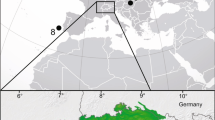Abstract
The temperature distribution through the Greenland ice sheet at the Dye 3 borehole is a record of the past climatic changes in the Arctic. The numerical model of the temperature distribution now presented reproduces the observed temperature distribution within 0.03 K, and shows that the basal ice is still cooled 5 K by the cold ice-age climate. The results suggest a mean ice-age temperature of −32 ± 2°C, which is 12 K colder than the present temperature, and a precipitation rate 50 ± 25% of the present rate. Calculations of a more detailed temperature history through the present inter-glacial period reveal evidence of the AD 1920–50 maximum, the little ice age, and the Atlantic period.
This is a preview of subscription content, access via your institution
Access options
Subscribe to this journal
Receive 51 print issues and online access
$199.00 per year
only $3.90 per issue
Buy this article
- Purchase on Springer Link
- Instant access to full article PDF
Prices may be subject to local taxes which are calculated during checkout
Similar content being viewed by others
References
Gundestrup, N. S. & Hansen, B. L. J Glaciol. 30, 282–288 (1984).
Zwally, H. J., Bindschadler, R. A., Brenner, A. C., Martin, T. V. & Thomas, R. H. J geophys.Res. 88, 1589–1596 (1983).
Overgaard, S. & Gundestrup, N. S. Am. geophys. Un. geophys. Monogr. 33, 49–56 (1985).
Whillans, I. M., Jezek, K. C., Drew, A. R. & Gundestrup, N. S. Ann. Glaciol. 5, 185–198 (1984).
Reeh, N. & Gundestrup, N. S. J Glaciol. 31, 198–200 (1985).
Reeh, N., Johnsen, S. J. & Dahl-Jensen, D. Am. geophys. Un. geophys. Monogr. 33, 57–66 (1985).
Dansgaard, W., Clausen, H. B., Dahl-Jensen, D. & Gundestrup, N. S. Proc. Symp. on EEC Climatology Programme. (1984).
Dahl-Jensen, D. J. Glaciol. 31, 92–98 (1985).
Dansgaard, W. & Johnsen, S. J. J. geophys. Res. 74, 1109–1110 (1969).
Dansgaard, W. & Johnsen, S. J. J Glaciol. 8, 215–223 (1969).
Budd, W. F., Young, N. W. & Austin, C. R. J. of Glaciol. 16, 99–110 (1974).
Lee, W. H. K. & Uyeda, S. Terrestial Heat Flow (ed. Lee, W. H. K.) (American Geophysical Union, Washington, DC, 1965).
Dansgaard, W. et al. Geophys. Monogr. 29 (1984).
CLIMAP Project Members, Geological Society of American Map and Chart Series MC—36(1981).
Beer, J. et al. Ann. Glaciol. 5, 16–17 (1984).
Hammer, C. U., Clausen, H. B. & Dansgaard, W. J. Volcan. geotherm. Res. 11, 3–10 (1981).
Lamb, H. H. Climate History and the Modern World. (Methuen, London, 1982).
Reeh, N. Nature 317, 797–799 (1985).
Author information
Authors and Affiliations
Rights and permissions
About this article
Cite this article
Dahl-Jensen, D., Johnsen, S. Palaeotemperatures still exist in the Greenland ice sheet. Nature 320, 250–252 (1986). https://doi.org/10.1038/320250a0
Received:
Accepted:
Issue Date:
DOI: https://doi.org/10.1038/320250a0
This article is cited by
Comments
By submitting a comment you agree to abide by our Terms and Community Guidelines. If you find something abusive or that does not comply with our terms or guidelines please flag it as inappropriate.



